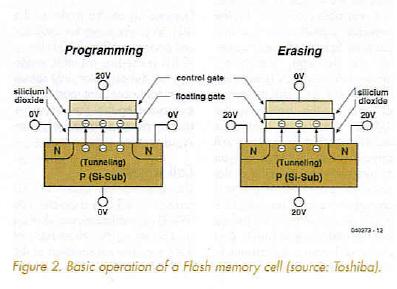

Project Solutions
USB Memory Stick: an ideal memory device 2
Published:2011/8/8 2:30:00 Author:Amy From:SeekIC
By Harry Baggen
Changing the drive letter
The block diagram gives a fair impression of the memory chip complexity — a lot of intelligence lurks inside the memory to make sure all processes run properly.
One of the main points to note with any Flash memory is reliability. Flash memory cells do not have eternal life an the odd cell may malfunction during operation. That’s why an extensive internal error checking system is available (ECC, error correction code). With all operations, (read, write, but also erasure), the data integrity is checked. In case an error is found, it is corrected and the contents of the entire ’block’ containing the error is copied to another, free, block in the memory.
The manufacturer claims a lifetime of 100,000 erasure and write cycles to the device. Data is held in the memory cells for at least 10 years.
How does a Flash memory work?
The basic construction of Flash memory is derived from the EPROM. Each memory cell consists of MOSFET with two gates (Figure 2). A floating gate is ’inserted’ between the control gate and the substrate of the FET. This floating gate employs an extremely thin layer of silicon dioxide hence forms a nearly perfect isolation, preventing electronics injected into the gate from leaking away when the supply voltage is switched off. The number of electrons present on the floating gate determines if a logic High or Low level is being stored. Cell programming and erasure is affected by applying a relatively strong field between gate and substrate, allowing electrons to travel across the isolation barrier. This process is called Fowler-Nordheim tunnelling. In the mean time, millions of USB memory sticks and cards have proved the reliability of Flash-based memory devices — they can be relied upon to keep your data secure for many years.

Reprinted Url Of This Article: http://www.seekic.com/blog/project_solutions/2011/08/08/USB_Memory_Stick__an_ideal_memory_device_2.html
Print this Page | Comments | Reading(1069)
Article Categories
New published articles
· Imagination works with TSMC to develop FinFET process
Author:Ecco Reading(30179)
· XMOS pushes event-driven MCUs with lower price
Author:Ecco Reading(3461)
· Intel brings upgraded 32-nm SoC for smartphones
Author:Ecco Reading(3181)
· Micron pushes TLC 128-Gbit NAND flash
Author:Ecco Reading(3661)
· Intel will stop supplying desktop motherboards
Author:Ecco Reading(5231)
· Processor market was expected to regain strength in 2013
Author:Ecco Reading(3248)
· It was reported that TSMC sales fall steeply
Author:Ecco Reading(3390)
· Cisco, NXP work with auto wireless startup
Author:Ecco Reading(3530)
· Micron was impacted by manufacturing glitch
Author:Ecco Reading(3935)
· China can make 22-nm transistor by themselves
Author:Ecco Reading(3707)
· Chip market rebound is coming, according to survey
Author:Ecco Reading(3677)
· Sony, Toshiba will spend more on chips, iSuppli reports
Author:Ecco Reading(3714)
· Qualcomm becomes the 13th company to join NFC Forum board
Author:Ecco Reading(6028)
· TSMC increases building work for FinFET fab
Author:Ecco Reading(3692)
· TI plans to cut 1,700 jobs in OMAP shift
Author:Ecco Reading(4478)